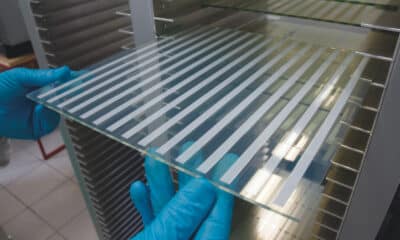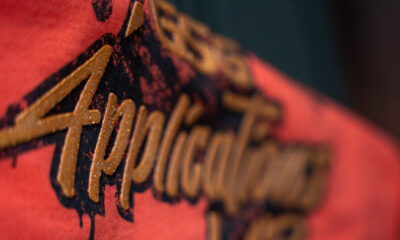Garment Printing
Published
21 years agoon
In recent columns, I’ve mentioned the cycles of preference in the decorated garment market and pointed out that, today, decorators are striving to produce prints with the softest hand possible as opposed to seeing how much ink they can stack on top of the fabric. In this installment, I will look at the latest trend in producing garment decorations with a soft hand–garment wash programs. Garment-wash programs have been around for years and are used by printers to achieve either a softer hand on the fabric or a worn effect in the print that is the current retail rage.
In recent columns, I’ve mentioned the cycles of preference in the decorated garment market and pointed out that, today, decorators are striving to produce prints with the softest hand possible as opposed to seeing how much ink they can stack on top of the fabric. In this installment, I will look at the latest trend in producing garment decorations with a soft hand–garment wash programs. Garment-wash programs have been around for years and are used by printers to achieve either a softer hand on the fabric or a worn effect in the print that is the current retail rage. Abrasive sand washes or chemical enzyme washes are the primary methods used to achieve both the soft hand and weathered look, and these processes are typically applied to jersey and fleece knit garments. Both methods provide varying degrees of softness and impart different finishes to printed garments. In traditional garment-wash programs, the fabric is knitted, dyed, cut, sewn as a garment, washed, and then printed. The result is a blank garment with a worn appearance and feel, to which a standard screen-printed image is then applied. Today, however, some printers are taking this process a step further by subjecting garments to these special washes after the printing process. Doing so has an effect on the print as well as the fabric, which is an aspect to consider during the printing process. Many retailers in today’s market want garments that look and feel like they have been worn and washed numerous times. The garment-wash process–whether sand or enzyme–abrades or degrades the ink film and the garment fabric and dyes in the same way, producing a print with a softer hand overall than the garment exhibited prior to the wash. Washing effects You can use current screen-printing technology to complement the washing process and create exciting results. For example, if you use retensionable frames to achieve high screen tensions and minimize ink-film deposits, you can use a garment wash cycle to abrade even more ink from the print and produce a more dramatic, weathered appearance. The basic rule of thumb when employing a wash program is that the thinner the ink film printed, the greater the effect that the specialty washing will have on that print. Thicker ink films will not yield as readily to the wash process and won’t produce as noticeable an effect. The goal in garment-wash applications is simply to have the final print appear to look worn and used. You’ll have to experiment in order to find the combination of printing and washing that provides the special-effect appearance and final image quality you want. Let’s assume that you’re printing a high-opacity white plastisol ink onto a navy-colored garment through a 140-thread/in. screen. The printed image is a typical, opaque, semi-soft print after curing. But once you wash the garment using either the sand or enzyme method, some of the original ink-film thickness will be abraded or degraded away and, depending on the original thickness, the garment may show through the printed areas to some degree. Upon inspection, the print might appear to suffer from poor opacity, and you might assume that the same effect could be achieved by printing with a finer mesh count. Although the appearance would be similar when applying a thinner deposit, using the wash process produces a soft-handed feel that the thinner deposit couldn’t match. More importantly, the wash process is the only way to create the distressed, all-over effects that customers are currently chasing. You’ll have more success producing these effects when you print flat colors directly onto the fabric. Using an underbase can work, but will not have quite the same effect. The impact of ink Specialty inks, such as high-density gels, crystallines, and clears, often produce a film thickness too great to reflect the effects of a wash program because they only show wear on the print surface. Standard plastisols, on the other hand, perform well because they form thinner deposits and show a greater degree of wear after they are washed. The prints that show the most significant effects from wash programs are process-color designs, which are about as thin as you can get. Regardless of the amount of ink that you print, it’s critical to run printed samples through a wash program prior to starting full-scale production. This is the only way to make sure that the resulting effects are what you want. In your early experiments with wash programs, you may experience nearly complete washout of your prints and assume that the abrasiveness of the wash method is too great. More likely, however, is that the problem results from an improperly cured print. Consequently, the need to test for proper cure becomes crucial prior to applying a wash program. As in traditional garment printing, water-based inks produce the softest hand on garments subjected to a wash program because these inks have such a low solids content. After undergoing a wash program, these inks leave a virtually undetectable residual ink film. For today’s retailers, garments featuring water-based inks that have undergone wash programs are the most desirable because they appear worn and have a virtually non-existent hand. Quality control Certain challenges are inherent to these specialty washing applications. One of the greatest is training your quality-control staff how to judge what is acceptable. They’ll need to be able to recognize the difference between your wash-program prints and those that previously would have been considered rejects due to poor coverage, fibrillation, or bleeding. These once undesirable results are considered acceptable in wash-program garments. Ensuring a properly cured ink film prior to specialty washing is equally important, whether you’re using water-based or plastisol inks. And ironically, the best way to test the cure is by…wash testing. Don’t send a production run to an industrial laundry for sand or enzyme washing until you’ve verified proper curing by sending samples through in-house wash testing at least three times. Once you are confident that the prints are properly cured, you can proceed to the industrial laundry with the goods. Once you’ve adjusted all the production parameters, you must create control samples against which you can measure results for acceptability or failure. The industrial wash process can and will produce varying degrees of abrasion/degradation to prints. Your objective should be to collect a range of finished samples that you can present to customers in order to establish what their standards of acceptability are. Once you identified the samples that satisfy customers, review them, and the process used to create them, with your quality-assurance department so that they have benchmarks for future jobs. Wash and learn Putting printed garments through the stress of sand or enzyme washing can open your product line to new markets. All it takes is careful experimentation and good record keeping, and you’ll be able to master the process.

Subscribe

Magazine
Get the most important news
and business ideas from Screenprinting Magazine.
Most Popular
-

 Case Studies2 months ago
Case Studies2 months agoHigh-Density Inks Help Specialty Printing Take Center Stage
-

 Art, Ad, or Alchemy2 months ago
Art, Ad, or Alchemy2 months agoF&I Printing Is Everywhere!
-

 Andy MacDougall2 months ago
Andy MacDougall2 months agoFunctional and Industrial Printing is EVERYWHERE!
-

 Columns3 weeks ago
Columns3 weeks ago8 Marketing Mistakes Not to Make When Promoting Your Screen Printing Services Online
-

 Editor's Note3 weeks ago
Editor's Note3 weeks agoLivin’ the High Life
-

 Marshall Atkinson3 weeks ago
Marshall Atkinson3 weeks agoHow to Create a Winning Culture in Your Screen-Printing Business
-

 Thomas Trimingham2 months ago
Thomas Trimingham2 months ago“Magic” Marketing for Screen Printing Shops
-

 Case Studies3 weeks ago
Case Studies3 weeks agoScreen Printing for Texture and Depth






